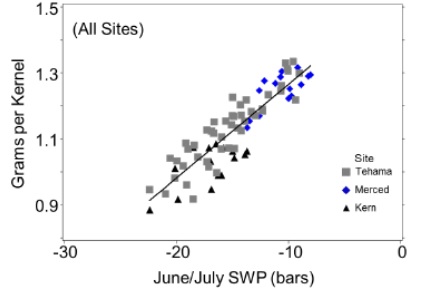
Summer irrigation is challenging. Water use of mature almond trees is the highest of the season, with an average evapotranspiration being around 2.00 acre inches of water use per week during June and July for most of the San Joaquin valley. This doesn’t consider distribution uniformity problems as well as any high heat events that may occur, which may require increased water applications.
During this period, it is common to see stressed trees. This is frequently due to the lack of or improper calculation of evapotranspiration (ETc) leading to under-irrigation. It may also be due to an under-performing irrigation system leading to poor distribution uniformity, in which some areas are getting over-irrigated while others are under-irrigated. Lastly, and sometimes surprisingly, poorly designed systems are commonly observed which aren’t able to meet the tree’s demand for the water in the summer. This is due to miscalculation or variable well/pump flows, too low of application which requires long pump times, or general poor design that limits water flows (i.e. reduced pipe sizes to save money).
Some stress during this period is okay. Mild water stress that occurs at the onset of hull-split has been shown to increase the uniformity (or ‘evenness’) of hull-split. Sometimes, especially in fine textured soils with high water holding capacities, this application of deficit irrigation can be applied earlier in June to draw down levels of stored soil moisture. In these cases, careful monitoring of tree stress through the use of a pressure chamber should occur. Water reductions should start in range of a 10-20% reduction. When trees reach a mid-day stem water potential (SWP) of 2-3 bars more negative than baseline, near-to-full irrigation should resume to reduce tree stress. As hull-split begins (~1% hullsplit, or when blanks split) AND there is a desire to reduce hull-rot, water should be reduced again to bring the trees into a SWP of -15 bars. This deficit should be maintained for two weeks. Near to full irrigation should resume after this period to help “pop” the nuts and return to minimal stress levels to maximize kernel weights.
Maintaining this stress too long or starting it too early, however may have a detrimental effect on kernel weights and corresponding yields. Based on research conducted across three locations in California studying the impacts of water applications, a strong correlation was found between tree stress that occurs in June and July and decreasing kernel weights (see figure). This means that a prolonged period of stress will REDUCE kernel weight by as much as 30%, depending on severity. This makes sense as tree stress reduces photosynthesis, which reduces the amount of carbohydrates that can be directed towards the developing nut (kernels continue to develop nearly to the point of harvest).
When determining if an irrigation deficit should occur, it is important to account aspects of tree physiology, operations and irrigation capabilities. Understanding the current development state of the tree in relationship to when it completed kernel fill, timing of blank split and hull-split, and the timing of harvest will influence how much and when of a deficit should be applied. This of course, should also be based on the ability of the operation to be able to apply water on a timely matter. Essentially a system that has near-real-time access to water will be better able to manage deficit irrigation than an orchard that has to wait 2-3 days for the water to be delivered. Finally, be sure that the irrigation system is able to meet the peak demand of the orchard. If it isn’t able to apply close to 2 inches of water, or peak summer calculated ETc in 84 hours (essentially, seven 12 hour sets), then a deficit is already being applied and water shouldn’t be reduced during this period.

